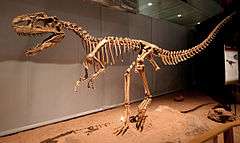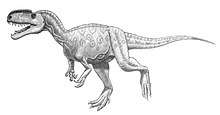Tetanurae
Tetanurae (/ˌtɛtəˈnjuːriː/ or "stiff tails") is a clade that includes most theropod dinosaurs, including megalosauroids, allosauroids, tyrannosauroids, ornithomimosaurs, maniraptorans, and birds.[5] Tetanurans are defined as all theropods more closely related to modern birds than to Ceratosaurus and contain the majority of predatory dinosaur diversity.[6] Tetanurae likely diverged from its sister group, Ceratosauria, during the late Triassic.[7] Tetanurae first appeared in the fossil record by the Early Jurassic about 190 mya and by the Middle Jurassic had become globally distributed.[6]
| Tetanurans | |
|---|---|
 | |
| Skeleton of Monolophosaurus jiangi | |
| Scientific classification | |
| Kingdom: | Animalia |
| Phylum: | Chordata |
| Clade: | Dinosauria |
| Clade: | Saurischia |
| Clade: | Theropoda |
| Clade: | Neotheropoda |
| Clade: | Averostra |
| Clade: | Tetanurae Gauthier, 1986 |
| Subgroups[1][2] | |
| |
| Synonyms | |
| |
The group was named by Jacques Gauthier in 1986 and originally had two main subgroups: Carnosauria and Coelurosauria, the clade containing birds and related dinosaurs such as compsognathids, tyrannosaurids, ornithomimosaurs, and maniraptorans.[8] The original Carnosauria was a polyphyletic group including any large carnivorous theropod.[9] Many of Gauthier's carnosaurs, such as tyrannosaurids, have since been re-classified as coelurosaurs or primitive tetanurans.[6] Carnosauria has been reclassified as a group containing allosaurids that split from the Coelurosauria at the Neotetanurae/Avetheropoda node.[6] Members of Spinosauroidea are believed to represent basal tetanurans.[6]
Tetanuran evolution was characterized by parallel diversification of multiple lineages, repeatedly attaining large body size and similar locomotor morphology.[6] Cryolophosaurus has been claimed as the first true member of the group, but subsequent studies have disagreed on whether it is a dilophosaurid or tetanuran.[6][10] Arcucci and Coria (2003) classified Zupaysaurus as an early tetanuran,[11] but it was later placed as a sister taxon to the clade containing dilophosaurids, ceratosaurs, and tetanurans.[12]
Shared tetanuran features include a ribcage indicating a sophisticated air-sac-ventilated lung system similar to that in modern birds.[9][13] This character would have been accompanied by an advanced circulatory system.[9][13] Other tetanuran characterizing features include the absence of the fourth digit of the hand, placement of the maxillary teeth anterior to the orbit, a strap-like scapula, maxillary fenestrae, and stiffened tails.[7][9][13] During the Late Jurassic and Early Cretaceous, large spinosaurids and allosaurs flourished but possibly died out in the northern hemisphere before the end of the Cretaceous, and were replaced as apex predators by tyrannosauroid coelurosaurs.[14] At least in South America, carcharodontosaurid allosaurs persisted until the end of the Mesozoic Era,[15][16] and died out at the same time the non-avian coelurosaurs.
Morphology

Anatomy
Tetanurans have two basic skull morphologies.[6] The first skull type, typical in large theropods such as Allosaurus, is common within ceratosaurs and may be primitive for tetanurans. In this type, the skull is about three times longer than tall, with a blunter snout and frequent elaborations such as horns or spikes along the lacrimals, nasals, and frontals.[6] In the second skull type, the skull is lower and longer, with a less elaborated skull roof and a more elongated snout.[6] Shared tetanuran features include the maxillary fenestra (an opening in the antorbital fossa), a pneumatic excavation in the jugal, and the position of the maxillary teeth anterior to the orbit.[7] The posterior skull is little modified in tetanurans, except within Spinosauridae.
In the postcranial skeleton, tetanurans transition between the most primitive theropod morphologies in basal tetanurans towards more derived, bird-like states in coelurosaurs.[6] Most tetanurans possess specialized wrist bones, the absence or reduction of the fourth digit of the hand, a strap-like scapula, stiffened tails, and a laminar astragalar ascending process.[7][9][13] Advanced tetanurans would have possessed a sophisticated air-sac-ventilated lung system similar to birds, and an advanced circulatory system.[9][13] In megalosaurids and allosaurids, the orientation of the femoral head is anteromedial such as in ceratosaurs, but in avetheropods this orientation is fully medial.[6] Tetanuran locomotor morphology is relatively generalized, with few variations between taxa.[6]
Body Size
Basal tetanurans were the first theropod clade to achieve truly giant body sizes, with both megalosauroid and allosauroid taxa weighing over 1 ton.[6] Sequential temporal appearances of large body size in subsequent clades suggest a pattern of size-cycles, with the extinction of incumbent giant forms allowing for replacement with a new, more bird-like theropod group that then also evolved giant body size.[6] It is, however, possible that more than one giant tetanuran existed at a time in the same paleoenvironment, perhaps with feeding habit variations. Within most dinosaur clades, body size tended to increase over time along a lineage according to Cope's rule.[17] Coelurosaurian theropods are the notable exception to the pattern of body size increases.[6]
History of study
History of classification
Tetanurae was recognized and named by Gauthier in 1986.[18] The earliest-discovered tetanuran is the earliest-named dinosaur, Megalosaurus.[6] For a century after the description of Megalosaurus, most large carnivorous dinosaurs were serially arrayed into the family Megalosauridae within the order Theropoda.[6] In 1914, Friedrich von Huene separated small, lightly built forms into the infraorder Coelurosauria and larger taxa into the infraorder Pachypodosauria.[6] Later, he transferred large, carnivorous taxa to the new infraorder Carnosauria, which came to include all known large-bodied carnivores other than Ceratosaurus.[6] The size-based arrangement persisted until Gauthier, who redefined Carnosauria and Coelurosauria based on new cladistic analyses but retained the terms.[18] Gauthier defined Coelurosauria as a taxon comprising birds and theropods closer to birds than to Carnosauria, and listed within Carnosauria several large-bodied theropod taxa but did not formally define the group.[18] Many of these original carnosaurs have since been reclassified as coelurosaurs or primitive tetanurans, and Carnosauria has now been defined as Allosaurus and all Avetheropods closer to Allosaurus than to birds.[19]
Initial cladistics studies supported the arrangement of primitive megalosaurs as serial outgroups to a clade of allosaurids, followed by the Coelurosauria. Subsequent studies have discovered that many of these basal tetanurans formed a true clade, termed Megalosauroidea or alternatively Spinosauroidea.[6]
Current phylogeny
Current phylogeny agrees on a monophyletic Tetanurae that includes a series of generally large-bodied basal taxa outside a monophyletic Coelurosauria.[6] Coelophysoids are basal to Tetanurae, with Ceratosauria forming a sister taxa that diverged during the late Triassic.[7]
After their initial appearance, Tetanurae radiated into two main clades, Spinosauroidea or Megalosauroidea and Avetheropoda or Neotetanurae.[19] Spinosauroidea are believed to represent basal Tetanurans. At the Neotetanurae/Avetheropoda node, allosaurids split from the Coelurosauria. Tyrannosauridae has been placed within Coelurosauria. The allosaurids and their closest relatives form a reconstituted Carnosauria.[6] Debate persists about whether the allosaurids form a clade with spinosauroids/megalosauroids, and whether Allosauroidea belongs in Avetheropoda with Coelurosauria or forms a sister taxa to Megalosauroidea, and whether Megalosauroidea forms a valid clade.[6]
The cladogram presented below follows a phylogenetic analysis published by Zanno and Makovicky in 2013.[14]
| Tetanurae |
| ||||||||||||||||||||||||||||||||||||||||||||||||||||||||||||
In 2019, Rauhut and Pol described Asfaltovenator vialidadi, a basal allosauroid displaying a mosaic of primitive and derived features seen within Tetanurae. Their phylogenetic analysis found traditional Megalosauroidea to represent a basal grade of carnosaurs, paraphyletic with respect to Allosauroidea.[20]
| Tetanurae |
| ||||||||||||||||||||||||||||||||||||||||||||||||||||||||||||
Paleobiology
Biogeography
The biogeographical history of non-avian Tetanurae spans over 110 million years and all continents.[6] The presence of major lineages prior to the breakup of Pangaea implies wide dispersal of these clades, with later absences indicating regional extinctions or dispersal failure.[6] The density of sampling is currently insufficient to provide a detailed analysis of biogeographical evolution for the Tetanurae.[6]
Diversity
Tetanurae and Ceratosauria likely diverged during the late Triassic, more than 200 mya. By the Early Jurassic, Tetanurae fossils appear in the fossil record and reached global distribution by the Middle Jurassic.[6] In the Late Jurassic, the fossil record demonstrates widespread presence of multiple clades within both megalosauroids and avetheropods.[6] The Megalosauroidea contained high diversity with two Jurassic clades, Piatnitzkysauridae and Megalosauridae, as well as the Cretaceous Spinosauridae.[6] Tetanuran evolution appears to exhibit waves of diversification, although this may be due to uneven sampling.[6] During the Late Jurassic and Early Cretaceous, large spinosaurids and allosaurids flourished, but the latter possibly died out before the end of the Cretaceous due to the Cenomanian-Turonian boundary event, while spinosaurids are known from the Santonian. Soon afterwards the niche of terrestrial apex predator ceratosaurs and tyrannosaurid coelurosaurs, which dominated terminal Cretaceous terrestrial ecosystems.[14] Coelurosaurs persisted through the end of the Mesozoic Era.[14] Modern birds are the only living representatives of the Tetanurae.[14]
References
- Hendrickx, C.; Mateus, O.V. (2014). Evans, Alistair Robert (ed.). "Torvosaurus gurneyi n. sp., the Largest Terrestrial Predator from Europe, and a Proposed Terminology of the Maxilla Anatomy in Nonavian Theropods". PLoS ONE. 9 (3): e88905. Bibcode:2014PLoSO...988905H. doi:10.1371/journal.pone.0088905. PMC 3943790. PMID 24598585.
- Carrano, M. T.; Benson, R. B. J.; Sampson, S. D. (2012). "The phylogeny of Tetanurae (Dinosauria: Theropoda)". Journal of Systematic Palaeontology. 10 (2): 211–300. doi:10.1080/14772019.2011.630927.
- Novas, F. E.; Salgado, L.; Suárez, M.; Agnolín, F. L.; Ezcurra, M. N. D.; Chimento, N. S. R.; de la Cruz, R.; Isasi, M. P.; Vargas, A. O.; Rubilar-Rogers, D. (2015). "An enigmatic plant-eating theropod from the Late Jurassic period of Chile". Nature. 522 (7556): 331–4. Bibcode:2015Natur.522..331N. doi:10.1038/nature14307. PMID 25915021.
- Benson, R. B. J.; Radley, J. D. (2010). "A New Large-Bodied Theropod Dinosaur from the Middle Jurassic of Warwickshire, United Kingdom". Acta Palaeontologica Polonica. 55: 35–42. CiteSeerX 10.1.1.601.354. doi:10.4202/app.2009.0083.
- "Tetanurae". www.ucmp.berkeley.edu. Retrieved 2016-06-03.
- Carrano, Matthew T.; Benson, Roger B. J.; Sampson, Scott D. (2012-06-01). "The phylogeny of Tetanurae (Dinosauria: Theropoda)". Journal of Systematic Palaeontology. 10 (2): 211–300. doi:10.1080/14772019.2011.630927. ISSN 1477-2019.
- Sereno P.C., Wilson J.A., Larsson, H.C.E., Dutheil D.B., & H. Sues. (1994). "Early Cretaceous Dinosaurs from the Sahara". Science. 266 (5183): 267–71. Bibcode:1994Sci...266..267S. doi:10.1126/science.266.5183.267. PMID 17771449.CS1 maint: multiple names: authors list (link)
- "Saurischian monophyly and the origin of birds". Memoirs of the California Academy of Sciences. 8. 1986-01-01. ISSN 0885-4629.
- "Palaeos Vertebrates Theropoda: Basal Tetanurae". palaeos.com. Retrieved 2016-06-03.
- Smith N. D.; Hammer W.R. & P.J. Currie (2005). "Osteology and phylogenetic relationships of Cryolophosaurus ellioti (Dinosauria: Theropoda): Implications for basal theropod evolution". Journal of Vertebrate Paleontology. 25 (3): 1–143. doi:10.1080/02724634.2005.10009942.
- Arcucci, Andrea B.; Coria, Rodolfo A. (2013-04-19). "A new Triassic carnivorous dinosaur from Argentina". Ameghiniana. 40 (2). ISSN 1851-8044.
- Hans-Dieter Sues, Sterling J. Nesbitt, David S. Berman and Amy C. Henrici (2011). "A late-surviving basal theropod dinosaur from the latest Triassic of North America". Proceedings of the Royal Society B. 278 (1723): 3459–3464. doi:10.1098/rspb.2011.0410. PMC 3177637. PMID 21490016.CS1 maint: multiple names: authors list (link)
- Weishampel D.B., Dodson P. & H. Osmólska (2004-12-06). The Dinosauria. University of California Press. ISBN 9780520941434.
- Zanno, Lindsay E.; Makovicky, Peter J. (2013-11-22). "Neovenatorid theropods are apex predators in the Late Cretaceous of North America". Nature Communications. 4: 2827. Bibcode:2013NatCo...4.2827Z. doi:10.1038/ncomms3827. PMID 24264527.
- Candeiro, Carlos Roberto A.; Currie, Philip J.; Candeiro, Caio L.; Bergqvist, Lílian P. (2017-01-16). "Tooth wear and microwear of theropods from the Late Maastrichtian Marília Formation (Bauru Group), Minas Gerais State, Brazil". Earth and Environmental Science Transactions of the Royal Society of Edinburgh. 106 (4): 229–233. doi:10.1017/s175569101600013x. ISSN 1755-6910.
- Fernandes de Azevedo, Rodrigo P.; Simbras, Felipe Medeiros; Furtado, Miguel Rodrigues; Candeiro, Carlos Roberto A.; Bergqvist, Lílian Paglarelli (March 2013). "First Brazilian carcharodontosaurid and other new theropod dinosaur fossils from the Campanian–Maastrichtian Presidente Prudente Formation, São Paulo State, southeastern Brazil". Cretaceous Research. 40: 131–142. doi:10.1016/j.cretres.2012.06.004. ISSN 0195-6671.
- Hone, D. W. E.; Keesey, T. M.; Pisani, D.; Purvis, A. (2005-05-01). "Macroevolutionary trends in the Dinosauria: Cope's rule". Journal of Evolutionary Biology. 18 (3): 587–595. doi:10.1111/j.1420-9101.2004.00870.x. ISSN 1010-061X. PMID 15842488.
- Gauthier, J. A. (1986-01-01). "Saurischian monophyly and the origin of birds". Memoirs of the California Academy of Sciences. 8. ISSN 0885-4629.
- Currie P.J. & K. Padian (1997). Encyclopedia of Dinosaurs. Academic Press. ISBN 9780080494746.
- Rauhut, Oliver W. M.; Pol, Diego (2019-12-11). "Probable basal allosauroid from the early Middle Jurassic Cañadón Asfalto Formation of Argentina highlights phylogenetic uncertainty in tetanuran theropod dinosaurs". Scientific Reports. 9 (1): 18826. doi:10.1038/s41598-019-53672-7. ISSN 2045-2322. PMC 6906444. PMID 31827108.
_(Antwerpener_Breiftaube).jpg)
.jpg)

















